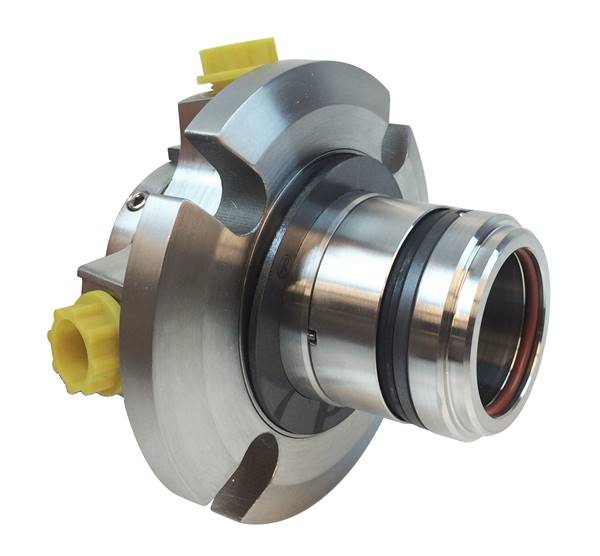Mechanical Seals Basics

Mechanical seals can save you lots of time and money, but understanding them can be very confusing. OnHandSupply.com wants to make it easier. So, let’s take a short walk through them and see if we can clear matters up.
There are only a handful of basic styles of mechanical seals, not hundreds. Here they are.
BASIC SEAL TYPES
- There is one group of mechanical seals with many names. They are called water pump seals, rubber bellows seals, Type 1 seals, “John Crane” seals, single spring seals and more. These are all turned by a molded rubber piece on the inside of the rotary unit.
- There are seals we call pusher seals. These have several parts and usually multiple springs.
- There are balanced O-ring seals. This is the most popular design for heavy-duty plant use.
- There are metal bellows seals.
- There are high-pressure seals.
OnHandSupply.com offers single and double, big bore or standard bore, balanced O-ring type cartridge seals in the 1⅜” and 1 ¾” sizes to fit the STX (small) and MTX (medium) pumps we sell. This seal uses its design geometry to hydraulically offset the closing force from the stuffing box pressure so that higher pressures do not directly translate into rapid face wear. They do not damage the shafts or sleeves they ride on.
CARTRIDGE SEALS
Now, let’s clear up the mystery about cartridge seals. Just substitute the word “pre-measured” for the word “cartridge.” That’s it. Just like dropping in an ink cartridge for a printer versus filling a reservoir, a cartridge seal is just a mechanical seal that was pre-measured at the factory so that no one has to do measurements in the field.
Any type of mechanical seal can be made into a cartridge seal. Cartridge seals really do help seal life. Although there are only four installations steps for a component seal, it is not easy to install one correctly. Why? Each step in installing a component seal requires measurements or calculations. All tolerances have to stack up. And, most seals have a paltry =/-.030” tolerance to be compressed correctly. That’s just 1/32” of an inch. Pre-measured compression of cartridge seals not only saves time, but also reduces the likelihood of installation error and seal failure. For this reason, cartridge seals may be worth the premium.
SINGLE SEALS vs DOUBLE SEALS
A double mechanical seal consists of two seals arranged in a series, either back to back or in tandem. The first seal acts just like the single seal, and the second seal is a secondary layer of protection from vapors or flush liquid entering the atmosphere.
Double mechanical seals are traditionally recommended for the following situations:
- When the process fluid has no lubricating properties such as water over 150 degrees F or lignin
- For top–entry mixers
- For toxic, carcinogenic or hazardous materials
- For strong vacuum service
- For flammable materials
More and more plants are using double seals in traditional single seal applications. This is so that if the inner seal fails, a plant can buy time for repairs to be done at a more convenient time. So, double seals are used where they must be used and/or where you choose to run them to have more flexibility on when you have to do maintenance work on your pumps.
DOUBLE SEAL ARRANGEMENTS
The orientation and arragement of the two sets of faces can be used to control the pressure of There are only three arrangements for any type of double seal. They can be face-to-face, back-to-back or tandem, meaning facing the same direction. OnHandSupply.com’s double seals can be configured for back-to-back or tandem arrangements.
Use the back-to-back orientation when the barrier fluid will be higher than the normal stuffing box pressure.
Use tandem when you want the barrier fluid pressure to be lower than the normal stuffing box pressure.
You can change the orientation in the field if you are comfortable handling mechanical seal parts or we can assemble the seal for you.
MATERIALS
.Now, let’s discuss materials. The face materials you need will depend on a variety of factors, such as the process fluid chemical properties, temperature, pressure, and maybe even the liquid that you use to wash down the pump. The face that rotates with the shaft (rotary face) is usually a softer material like carbon. The stationary face is usually harder like silicon-carbide. We offer face materials of carbon and silicon-carbide. To be more specific, we use high-purity, chemical-grade, carbon-graphite, and sintered-alpha silicon-carbide. We don’t like mysterious names that cover up what the materials are. You need to know and you have the right to know what you are putting in your equipment.
The metal parts of the mechanical seal must withstand the chemical corrosiveness of the process fluid. All metal parts in OnHandSupply.com mechanical seals are 316 stainless steel.
O-ring materials are also important - these rubber compounds must not warp or corrode upon contact with process fluid or from the pressure or temperature. We offer O-rings in Aflas.




